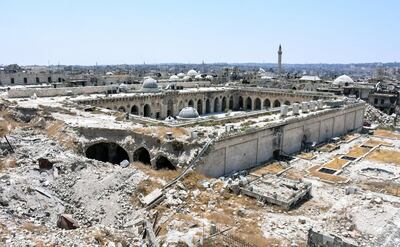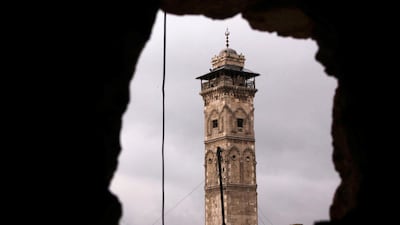“I have no idea why I was chosen for this job,” says Misbah Baqi, chief engineer in charge of rebuilding Aleppo’s holiest site. “Before this project I built Aleppo airport.”
I'm in the courtyard of Aleppo's Great Mosque, having been invited to Syria as part of "the Crazy Club", a group of British peers, clergy, academics, artists, writers and journalists on a visit billed as "pastoral". We are here to see a version of Syria's civil war, one recounted by the government of President Bashar Al Assad.
Since the fall of Aleppo in December 2016, the regime has seized both the city and the narrative, attempting to ensure its version of the truth is broadcast loudest. One example is that the government lays responsibility for Aleppo's destruction firmly at the door of “the terrorists”.
That includes the destruction of Aleppo's Grand Mosque and its spectacularly collapsed thousand-year-old Seljuk minaret. If only a building could speak and tell its secrets, none, perhaps, could tell us more about the ebb and flow of Syria’s war than this once magnificent structure. Here in the courtyard I am witnessing first-hand the busy restoration of a building whose fate I have followed closely for the last seven years.
Thanks to apolitical cultural heritage websites like www.apsa2011.com, damage to sites all over Syria has been meticulously catalogued in real-time, offering a clear chronology. Images dated 26 February 2013 show the mosque's unique 11th century minaret – an exquisite structure whose four sides were covered in Kufic inscriptions and elegant tracery reminiscent of Venetian facades – being hit by a projectile fired from the direction of the regime-held citadel. The 45 metre tall tower long since had a slight lean, the result of blocked drains undermining its foundations. The moment of its collapse in April 2013 was not caught on camera, but immediately afterwards the regime blamed "terrorists" for blowing it up with mines. The rebels counterclaimed that the regime had laid the mines when they controlled the mosque, then repeatedly tried to detonate them with tank shelling once the rebels took the structure over, succeeding finally on 24 April 2013.
Today funding for the mosque's restoration, said to amount to £5.5 million, comes from the Chechen Republic and Ramzan Kadyrov, a leader not previously known for his philanthropy. The work has been ongoing for a year and will take another two, says Baqi. But while speedy teams of workers on the roof install new decorative stonework, and carpenters rush to make new latticework from local walnut and wood imported from Canada, some secrets are less easy to erase.
Videos from May 2013 show the priceless 15th century minbar, or pulpit, being carefully dismantled by rebel civil activists to save it from fire. The video has a running commentary of the 10 day operation, explaining how they will hide its parts in various secure places until it is safe to return and reassemble it. Today they stand accused of selling it in Turkey. Further footage shows them constructing a protective bomb blast wall in front of the Tomb of Zachariah inside the mosque after regime snipers damaged the centuries-old tilework by firing at the rebels. The sniper position in the building opposite the tomb is filmed, as is the bandaging of the hand of an activist shot by a sniper while erecting the wall. Today the government blames the tile damage on those who built the wall, itself now removed without trace.

The earliest incarnation of the Aleppo Umayyad Mosque goes back to 715 when it was built in the gardens of the Cathedral of St Helena, the biggest of Aleppo’s 70 churches. “Christian temples” were allowed to flourish until the Crusaders arrived in 1124, burning crops, cutting trees, destroying shrines and plundering tombs to the west of the city. Earlier in 962, Byzantine forces had invaded the city, pillaging then torching the Great Mosque and adjacent souks. Two subsequent waves of Mongol hordes also laid waste to the city and its monuments, led first by Hulagu in 1260, then Tamerlane in 1400. The minaret survived it all. Now, for the first time in its turbulent history, the minaret, the mosque and indeed the city itself has been destroyed by its own rulers.
But the truth about what this sacred space witnessed in the war is now being concealed under a cloak of restoration. State-funded RT (Russia Today) reporters repeat accusations of “terrorists” desecrating the mosque. Regime-approved figures, like the Grand Mufti and the Christian Mar Ignatius Ephrem II, appear on YouTube speaking of “crimes against civilisation”.
____________
Read more:
Life in the slow lane of isolated Aleppo
An eerie silence prevails in Assad's 'reconstructed' Homs
There's only one winner from missile strikes in Damascus
____________
International cultural historians have a duty to keep the records that show how rebels – now damned as terrorists – went to great lengths to preserve and protect their heritage, while continual regime bombardment damaged virtually every mosque in Aleppo.
Chief engineer Baqi works for the Syrian military construction company Al-Iskaan Al-‘Askeri and takes orders directly from the president’s office, not, as would be usual, from the Ministry of Religious Affairs. No doubt he will do his best, helped by detailed three-dimensional imagery produced by an Italian team's photogrammetric study carried out in the 1990s prior to a major renovation completed in 2003. Reassembling the numbered stones of the minaret that now cover the courtyard will be a major challenge, a symbol perhaps of the mammoth task of rebuilding Syria that lies ahead, a giant jigsaw that may defy even Baqi’s boss, that most determined of social engineers.
One small final secret remains intact however, testimony to the lengths the rebels went to in saving the mosque's treasures. Videos on the www.apsa2011.com website show how the medieval sundial in the courtyard, originally used for giving accurate prayer times, was encased in sandbags, then sealed with a padlock and encircled with breeze block walls. It stands there still, seals intact, somehow overlooked by engineers and propagandists, a small and solitary but defiant reminder of who protected what in this seven year war. It is one stubborn part of the jigsaw that still refuses to fit.
Diana Darke is the author of author of My House in Damascus (2016) and The Merchant of Syria (2018)

